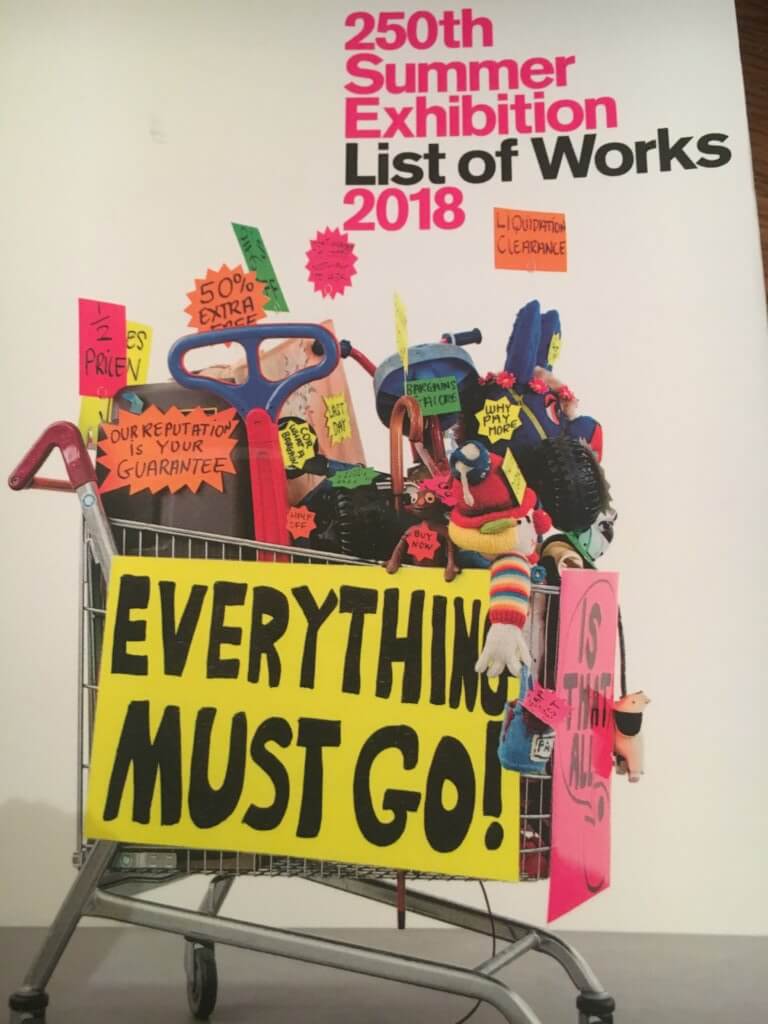
I visited the Royal Academy Summer Exhibition on Thursday. A friend had gone the day before and that nudged me towards going, and a meeting had to be postponed due to a domestic concern of the other party so I had the motive and the opportunity – and the means was a fairly reasonable £16.
In the current weather it’s a cool place to be.
I was interested to see what was on the walls, and whether nature would figure much at all. It doesn’t. You’d get the impression that artists are more interested in bums and breasts than in birds and bees – but then, we’ve all gone through that phase haven’t we?
Does this count as nature? It was certainly one of the most memorable and striking exhibits.
These two Norman Ackroyd’s caught my eye – Barra Head from Mingulay and Off Herma Ness Shetland.
Black Swan didn’t move me much.
I wouldn’t give house space to Bronze Mannikin even if I had the £18,500 to purchase it. Can anyone help me here – what am I missing?
Also unsold was Nigel Farage – a snip, obviously, at £25,000. This is a very clever piece of work – Farage looks weak and foolish. It made me smile but who would want it hanging on their wall (you need a big wall too)?
Portrait of Robert is sold, no doubt to a reader of Birdwatch magazine.
My Name is not Colin is still available.
Cleansing of the Poor was memorable – I wish there were rather more, similarly angry environmental images available.
I doubt that Melania Trump would be looking to have this on her wall – do not click here if of a sensitive easily-offended disposition.
Worth a visit, worth the entrance fee and all human life is here, but not very much of the rest of life on earth.
[registration_form]
Re Bronze Mannikin – I think it’s a mix of gullibility and egotism that you are missing.
There has long been an antipathy towards figurative wildlife art within the art establishment, nearly 40 years ago as a mature student in art college I challenged this dogma and found no real cogent explanation, considering one of the bastions of the college ( and a fine artist in every sense) was full of praise for Durer and his Rollers wing, Clumps of grass and a young hare, but failed to recognise my burgeoning, if limited talent and was dismissive of my efforts of similar work on the basis ‘it had all been done before’. Tell me, in art, what hasn’t? And, of course, none of it has been done by me, before. I came to the conclusion that the ‘art establishment’ is reluctant to give credence to figurative wildlife art as they are generally unable to confirm the accuracy or context of the representation and so cannot impose on the viewing, buying public their own sense of ‘value’. This also underpins the massive trend in modern views of art to dismiss and downplay both the art of learning to draw, or the need to understand light, form and colour and tone. There arr movements in wider art against this, but there is a tradition in continental Northern Europe following a tradition expressed in my feeble German as ” Kunst komt auf kunen”, ( ‘Art comes from being able’). ‘Bronze manakin’ reveals little ability of even good observation, let alone graphic skill. This sums up why I do not even attempt to submit to the Summer Exhibition, sad really given that the likes of Charles Tunniclifffe R.A. was a regular contributor of figurative wildlife and animal pictures.
Perhaps lack of representation of nature in ‘art’ is why there are times I struggle to appreciate or even recognise what some would consider ‘art’ as offered by ‘professional experts’?
Cleansing of the Poor was as you say memorable but how many visitors to the exhibition will see the message?
Art, like beauty is in the eye of the beholder?
If these offerings are today’s / current ‘art’ then I’ll stick with nature’s alternative which I capture with a camera.
In anticipation of lots of dislikes for my failing to recognise exciting new trends …..
“Cleansing of the Poor was as you say memorable but how many visitors to the exhibition will see the message?”
It’s hardly obscure – I would imagine that only the very dimmest of visitors to the exhibition would fail to see the message. Whether they are moved by it, agree with it or will do anything in response to it are rather different questions…
Perhaps.
The images floating around of what must be millions of tons of plastic in oceans (& the countryside, beaches etc.) are hardly obscure but how many folk have acted upon the plea by Attenborough et. al.?
There was one massive, brilliant exception – David Hockney’s 2012 ‘A bigger picture’. His huge woodland pictures were simply fantastic – especially as I (and I think many others) who know the Wolds wouldn’t see them as the most exciting landscape – until Hockney saw it for us. What was really interesting and probably says a lot in support of Mark’s thoughts is that the critics were distinctly luke warm – he’d committed crimes against contemporary art & his own image with things like a room full of very good, conventional landscape watercolours. Being Hockney, he reminded everyone that he’s a very good conventional representative artist with some exquisite line drawings – especially wood at roadside and its pair, wood gone – the sort of thing I thought only foresters could ever find exciting !
But the sting was that, whatever the critics thought, the public absolutely loved it – and quite rightly, too.